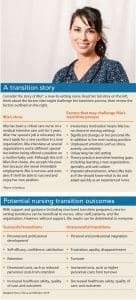The nursing process can help guide nurses through this career change.
ALL NURSES experience a professional role transition when they move from student nurse to practicing nurse, and this transition is frequently accompanied by high stress and anxiety. Much literature has been devoted to understanding and supporting new graduates as they acclimate to their new professional roles.
Transitions among practicing nurses, however, have been studied far less, even though most will make at least one more professional role change, and many will make multiple moves throughout their careers. They may move away from their specialty area into advanced (advanced practice, academic or clinical educator, leadership) and/or lateral roles (staff positions in new settings, units, specialties, organizations). As their roles change, they may experience some of the same challenges they faced as new nurses. This article focuses on understanding lateral clinical (new-to-setting) transitions and the evidence-based strategies to support experienced nurses making a career change.
Understanding the new-to-setting nurse
New-to-setting nurse transitions, identified in a recent concept analysis by Chicca and Bindon, can be defined as experienced nurses making lateral moves from one clinical setting to another, resulting in positive and negative outcomes for them, the organizations they work for, and the patients they serve. Based on available empirical and experiential evidence, new-to-setting nurses undergo difficult movement processes that may be similar to or even more complicated than new graduate nurse transitions. (See A transition story.)
experienced nurses making lateral moves from one clinical setting to another, resulting in positive and negative outcomes for them, the organizations they work for, and the patients they serve. Based on available empirical and experiential evidence, new-to-setting nurses undergo difficult movement processes that may be similar to or even more complicated than new graduate nurse transitions. (See A transition story.)
The lack of nursing literature on the topic of new-to-setting nurse transitions means we don’t fully understand the complex, nonlinear processes involved. Future study can help elucidate these processes to better guide support. Sample research, evidence-based practice, and/ or quality improvement questions could include:
- What processes are involved in new-to-setting nurse transitions?
- What are the perceived support needs of new-to-setting nurse transitions from the nurse, preceptor, leadership team, and organizational perspectives?
- What evidence-based strategies can facilitate a successful transition?
- What are the barriers or challenges to a successful transition?
- How does the new-to-setting nurse transition process reflect current new graduate nurse theories, frameworks, and models?
Authors tend to disagree on what constitutes an experienced nurse, with many suggesting that practicing for between 1 to 5 years is essential. I suggest that 1 year or more of practice experience defines an experienced nurse. After the 1-year mark, many organizations hire nurses as experienced and alter transition supports. For example, they decrease orientation length and eliminate transition support programs, such as residency or fellowship programs. This can result in challenges for new-to-setting nurses.
Evidence-based strategies
Successful and unsuccessful transitions affect healthcare professionals and organizations in many ways. (See Potential nursing transition outcomes.) Although more study is needed, existing evidence can serve as a foundation to help guide new-to-setting nurse transition support, particularly when considered within the context of the nursing process. All professionals, including nursing managers, educators, organizational leaders, preceptors, and peers, can use these strategies to help ensure successful transitions.
Assess
Gather information about the new-to-setting nurse. Assess the knowledge, skills, and abilities the transitioning nurse gained from his or her previous roles and experiences. Consider having an honest discussion about the motivations for the move as they could impact the nurse’s readiness to learn and adaptation to the new setting. As an alternative or in addition to a formal conversation, ask the nurse to complete a questionnaire to gather this information.
As part of the assessment, co sider what resources are available to help the new-to-setting nurse. Ask what, where, and when resources are available. (See Evidence-based resources.)
- experienced preceptors
- structured transition programs (for example, adapted residency programs)
- peer mentors
- specialty classroom training (for example, basic critical care classes)
- knowledge, skills, and abilities questionnaire or a list of specialty-specific orientation competencies needed for the new setting.
Consider implementing these evidence-based practices to guide new-to-setting nurses through their transition.
- Use consistent experienced preceptors, ideally one to two preceptors per new-to-setting nurse.
- Connect the new-to-setting nurse to formal and informal nursing leaders.
- Ensure two-way feedback (both positive and negative) is occurring and encouraged.
- Be welcoming and open to all questions and concerns.
- Help the new-to-setting nurse develop relationships with others.
- Provide specialty classroom training as needed.
- Use the competency-based, rather than time-based, orientation model.
- Offer a structured transition program beyond the orientation period.
Diagnose
After reviewing the assessment information, identify actual and potential problems that may arise during the transition. Actual problems will likely exist in the form of theory-practice and other learning gaps, so pinpoint gaps in knowledge, skills, and abilities early. What competencies are missing that are essential to this setting? In addition, diagnose any problems in the resources needed to support the new-to-setting nurse. For example, are experienced preceptors available?
Potential problems may be harder to diagnose. Knowing the new-to-setting nurse’s motivation for moving may be helpful in ascertaining these challenges. For example, does the nurse have unrealistic expectations for working in the new setting? Did the nurse choose to leave the last setting or was he or she forced to leave? These factors may provide clues to potential problems influencing new-to-setting nursing transitions.
Share actual and potential problem diagnoses with the new-to-setting nurse, invite feedback, ask if everything was captured accurately, and request any additions. Honesty and transparency will help ensure successful transitions.
Plan
After assessing and agreeing upon actual and potential problems, make a plan of action. Connect assessment information and diagnoses to make a collaborative plan of action with the nurse. Create SMART (Specific, Measurable, Achievable, Relevant, and Time-bound) goals as part of the planning process and identify evidence-based practices that help nursing transitions. (See Evidence-based practices.) Budgetary, time, and other constraints may require some creativity in implementing this plan of action. For example, if a nurse is struggling with electrocardiogram interpretation, plan for him or her to practice with a preceptor or leader for 4 hours.
Implement
Follow through on the plan of action and comprehensively document all efforts according to facility policy and procedure. Require transparent feedback, reflections, and communications from all parties, including new-to-setting nurses, peers, preceptors, and leadership, during implementation and evaluation.
Evaluate
Use formal conversations and/or questionnaires with both open- and closed-ended items to gather feedback and reflections. Also review documentation such as skills checklists. Consider gathering relevant data specific to new-to-setting nurses, such as retention statistics, to evaluate if they’re successfully transitioning. Disseminate and share evaluation successes and areas for improvement locally and nationally to help future transitions.
Transition success
Despite empirical and experiential evidence suggesting that nurses making new-to-setting transitions face many challenges, little guidance exists in the literature. Lack of understanding and little transition support for these nurses can result in unsuccessful transitions with detrimental effects to healthcare professionals and systems. Implementing evidence-based strategies to support new-to-setting nurses can be beneficial to healthcare professionals, the organizations they work for, and the patients they serve.
Jennifer Chicca is a PhD candidate and graduate assistant at Indiana University of Pennsylvania in Indiana.
Selected references
Ashley C, Halcomb E, Brown A, Peters K. Experiences of registered nurses transitioning from employment in acute care to primary health care—Quantitative findings from a mixed-methods study. J Clin Nurs. 2018;2 7(1-2):355-62.
Bell R, Bossier-Bearden M, Henry AA, Kirksey KM. Transitioning experienced registered nurses into an obstetrics specialty. J Contin Educ Nurs. 2015;46(4):187-92.
Benner P. From Novice to Expert: Excellence and Power in Clinical Nursing Practice. Upper Saddle River, NJ: Prentice-Hall; 2001.
Chicca J, Bindon S. New-to-setting nurse transitions: A concept analysis. J Nurses Prof Dev. 2019;35(2):66-75.
Dellasega C, Gabbay R, Durdock K, Martinez-King N. An exploratory study of the orientation needs of experienced nurses. J Contin Educ Nurs. 2009;40(7):311-6.
Dickerson P. Core Curriculum for Nursing Professional Development. 5th ed. Chicago, IL: Association for Nursing Professional Development; 2017.
Duchscher JB. A process of becoming: The stages of new nursing graduate professional role transition. J Contin Educ Nurs. 2008; 39(10):441-50.
Duchscher JE. Transition shock: The initial stage of role adaptation for newly graduated registered nurses. J Adv Nurs. 2009;65(5): 1103-13.
Gohery P, Meaney T. Nurses’ role transition from the clinical ward environment to the critical care environment. Intensive Crit Care Nurs. 2013;29(6):321-8.
Jeffrey AD, Jarvis RL, Word-Allen AJ. Staff Educator’s Guide to Clinical Orientation: Onboarding Solutions for Nurses. 2nd ed. Indianapolis, IN: Sigma Theta Tau International; 2018.
Kramer M. Reality Shock: Why Nurses Leave Nursing. St. Louis, MO: C.V. Mosby Co.; 1974.
Windey M. Growing an experienced nurse fellowship: Challenges and opportunities. J Nurses Prof Dev. 2016;32(6):319-20.



















2 Comments.
Many “new to setting” transitions take place on the fly, “floating” dictated by short staffing in specialty units. The timing of such events leaves little room for transition planning. Cross-training and mentoring before the fact can pave the way for smooth transitions when conditions dictate such moves. Cross-training staff strengthens the nursing cadre of the facility, provides individual nurses an opportunity to “try on” other professional practice roles, provides variety in work experience, lessens staff/management stress and decreases liability issues associated with adverse outcomes when an unprepared nurse is ordered to practice in a specialty area.
Or, first chance they get, they might go back to school for an MBA!